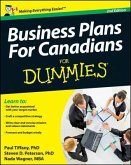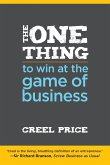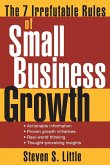24,99 €
inkl. MwSt.
Versandfertig in über 4 Wochen

12 °P sammeln
- Broschiertes Buch
- Merkliste
- Auf die Merkliste
- Bewerten Bewerten
- Teilen
- Produkt teilen
- Produkterinnerung
- Produkterinnerung
Breaking down complex concepts into simple and effective action plans, author Jan King will help you profit from her extensive experience and avoid common mistakes. This new revised edition elaborates on the six critical principles of running a small business that helped guide King to success: Set standards and give your employees the tools to meet your goals Lead by example Look to the long termthe very long term Find the important details and focus on them Watch for variances from expected results Face reality when you look at your company and take action "Business Plans to Game Plans will…mehr
Andere Kunden interessierten sich auch für
![Business Plans for Canadians for Dummies Business Plans for Canadians for Dummies]() Paul TiffanyBusiness Plans for Canadians for Dummies24,99 €
Paul TiffanyBusiness Plans for Canadians for Dummies24,99 €![The One Thing to Win at the Game of Business The One Thing to Win at the Game of Business]() Creel PriceThe One Thing to Win at the Game of Business32,99 €
Creel PriceThe One Thing to Win at the Game of Business32,99 €![The 7 Irrefutable Rules of Small Business Growth The 7 Irrefutable Rules of Small Business Growth]() Steven S LittleThe 7 Irrefutable Rules of Small Business Growth16,99 €
Steven S LittleThe 7 Irrefutable Rules of Small Business Growth16,99 €![The Barclays Guide to Financial Management for the Small Business The Barclays Guide to Financial Management for the Small Business]() Peter WilsonThe Barclays Guide to Financial Management for the Small Business24,99 €
Peter WilsonThe Barclays Guide to Financial Management for the Small Business24,99 €![The Game of Inches The Game of Inches]() Nigel CollinThe Game of Inches15,99 €
Nigel CollinThe Game of Inches15,99 €![Incorporating Your Business for Dummies Incorporating Your Business for Dummies]() The Company CorporationIncorporating Your Business for Dummies20,99 €
The Company CorporationIncorporating Your Business for Dummies20,99 €![Play a Bigger Game Play a Bigger Game]() Rowdy McLeanPlay a Bigger Game16,99 €
Rowdy McLeanPlay a Bigger Game16,99 €-
-
-
Breaking down complex concepts into simple and effective action plans, author Jan King will help you profit from her extensive experience and avoid common mistakes. This new revised edition elaborates on the six critical principles of running a small business that helped guide King to success: Set standards and give your employees the tools to meet your goals Lead by example Look to the long termthe very long term Find the important details and focus on them Watch for variances from expected results Face reality when you look at your company and take action "Business Plans to Game Plans will help you turn your vision into a thriving business equipped to weather any market! Order today!
Hinweis: Dieser Artikel kann nur an eine deutsche Lieferadresse ausgeliefert werden.
Hinweis: Dieser Artikel kann nur an eine deutsche Lieferadresse ausgeliefert werden.
Produktdetails
- Produktdetails
- Verlag: Wiley
- Revised edition
- Seitenzahl: 288
- Erscheinungstermin: 18. Dezember 2003
- Englisch
- Abmessung: 280mm x 210mm x 16mm
- Gewicht: 725g
- ISBN-13: 9780471466161
- ISBN-10: 0471466166
- Artikelnr.: 22130686
- Herstellerkennzeichnung
- Libri GmbH
- Europaallee 1
- 36244 Bad Hersfeld
- gpsr@libri.de
- Verlag: Wiley
- Revised edition
- Seitenzahl: 288
- Erscheinungstermin: 18. Dezember 2003
- Englisch
- Abmessung: 280mm x 210mm x 16mm
- Gewicht: 725g
- ISBN-13: 9780471466161
- ISBN-10: 0471466166
- Artikelnr.: 22130686
- Herstellerkennzeichnung
- Libri GmbH
- Europaallee 1
- 36244 Bad Hersfeld
- gpsr@libri.de
JAN B. KING was the president and CEO of Merritt Publishing from 1991 through 1998, transforming this small business into a recognized financial publishing brand and one of the fifty largest woman-owned and run businesses in Los Angeles, according to the Los Angeles Business Journal. She is currently a writer and business consultant, who in 2002 received the award for "Outstanding Performance as a Small Business Woman's Advocate" from the SBA/California Small Business Development Centers.
PART I. CREATE YOUR VISION.
1. Moving From Vision to Action.
Inventing Your Company.
Living the Vision.
An Ongoing Process.
Tools for Moving from Vision to Action.
Creating Your Vision.
Crafting a Mission Statement.
Analyzing Your Strengths, Weaknesses.
Opportunities, and Threats.
Defining Corporate Goals.
Action Plans: Turning Vision into Action.
Visually Representing Your Plans.
PART II. SET HIGH STANDARDS.
2. Creating a Budget Everyone Can Use and Understand.
The Budget Sets Priorities.
Know When to Stop.
Plan for Debt.
Follow the Money.
Control Expenses.
Plan for Cash.
Budget for the Big Items.
Plan for Profits.
Set Financial Controls.
Revenue Forecasts.
Profits Determine Survival.
Tools for Creating a Budget Everyone Can Use.
Revenue Budget.
Average Selling Price Per Product.
Unit Sales by Product.
Dollar Sales Projections by Product.
Dollar Sales Projections by Month.
Expense Budgeting.
The Budget Notebook.
Payroll Projections.
Income Statement Projections.
Break-Even Analysis.
3. Understanding the Numbers.
Flying Blind.
Traditional Financial Statements.
Cash Flow is Critical.
Following what matters.
Sharing Financial Information with Employees.
Tools for Understanding the Numbers.
Year-at-a-Glance Income Statement.
Year-at-a-Glance Balance Sheet.
Year-at-a-Glance Financial Analysis.
Budget Variance Report.
Same Month Last Year Variance Report.
Analysis of Cash Position.
Key Financial Indicators.
Financial Report to Employees.
PART III. BUILD LONG-TERM GROWTH.
4. Mastering the Art of the Sale.
Sales and Profitability.
Customer Focus.
Who Are Your Customers?
Quality Sales.
The Right Person for the Job.
Customer Service Professionals.
Sales Management.
Communicating Sales Data to Employees.
Tools for Mastering the Art of the Sale.
Dollar Sales Month-to-Month.
Product Sales by Customer.
Top-Selling Products.
Sales by Salesperson.
Customer Service Key Indicators.
Customer Service Survey.
Sales Report to Employees.
5. Achieving Quality and Quantity.
Setting the Right Standards.
Adding New Value.
What Your Inventory Tells You.
Supplier Concerns.
Tools for Achieving Quality and Quantity.
Unit Output by Product.
Units Shipped.
Average Days to Ship.
Returns Analysis.
Backlog of Orders.
Inventory Control Report.
Business Partner (Supplier) Survey.
6. Growing Profitably with Marketing and Product Development.
Research Your Market.
Customer Marketing Data.
Marketing Activities.
Product Development.
Sources of Innovation.
Assessing Costs and Risks.
Minimizing Risk.
Marketing Goals.
Tools for Marketing and Product Development.
Assessment of Competition.
Product Sales by marketing Method.
Product Development Checklist.
PART IV. LEAD WITH COURAGE.
7. Driving Employees to Peak Performance.
Set the Standards for Your Employees.
Invest in People.
Effective Communication.
Compensate Fairly and Well.
Make Time to Manage.
Human Resource Administration.
Avoiding Lawsuits.
Tools for Managing and Motivating Employees.
Performance Reviews.
Team Feedback.
Management Skills Feedback.
Employee Ranking System.
Human Resource Key Indicators.
8. Leading Your Business for maximum Results.
Personal Characteristics of CEOs.
Facing the Toughest Questions.
Look to the Long Term-the Very Long Term.
Finding the Important Details and Focus on Them.
Leading during Time of Growth.
Managing Slumps.
You Can't Do it Alone.
Getting Outside Help.
Hiring Quality Consulting Help.
Boards of Directors and Advisors.
Starting Over: The Annual Game-Planning Process.
Tools for Leading Your Business.
Employee Opinion Survey.
Company Performance Review.
Appendix One. The 50 Critical Management Questions to Running a Successful
Business.
Appendix Two. Top 50 Practical Business Books.
Index.
1. Moving From Vision to Action.
Inventing Your Company.
Living the Vision.
An Ongoing Process.
Tools for Moving from Vision to Action.
Creating Your Vision.
Crafting a Mission Statement.
Analyzing Your Strengths, Weaknesses.
Opportunities, and Threats.
Defining Corporate Goals.
Action Plans: Turning Vision into Action.
Visually Representing Your Plans.
PART II. SET HIGH STANDARDS.
2. Creating a Budget Everyone Can Use and Understand.
The Budget Sets Priorities.
Know When to Stop.
Plan for Debt.
Follow the Money.
Control Expenses.
Plan for Cash.
Budget for the Big Items.
Plan for Profits.
Set Financial Controls.
Revenue Forecasts.
Profits Determine Survival.
Tools for Creating a Budget Everyone Can Use.
Revenue Budget.
Average Selling Price Per Product.
Unit Sales by Product.
Dollar Sales Projections by Product.
Dollar Sales Projections by Month.
Expense Budgeting.
The Budget Notebook.
Payroll Projections.
Income Statement Projections.
Break-Even Analysis.
3. Understanding the Numbers.
Flying Blind.
Traditional Financial Statements.
Cash Flow is Critical.
Following what matters.
Sharing Financial Information with Employees.
Tools for Understanding the Numbers.
Year-at-a-Glance Income Statement.
Year-at-a-Glance Balance Sheet.
Year-at-a-Glance Financial Analysis.
Budget Variance Report.
Same Month Last Year Variance Report.
Analysis of Cash Position.
Key Financial Indicators.
Financial Report to Employees.
PART III. BUILD LONG-TERM GROWTH.
4. Mastering the Art of the Sale.
Sales and Profitability.
Customer Focus.
Who Are Your Customers?
Quality Sales.
The Right Person for the Job.
Customer Service Professionals.
Sales Management.
Communicating Sales Data to Employees.
Tools for Mastering the Art of the Sale.
Dollar Sales Month-to-Month.
Product Sales by Customer.
Top-Selling Products.
Sales by Salesperson.
Customer Service Key Indicators.
Customer Service Survey.
Sales Report to Employees.
5. Achieving Quality and Quantity.
Setting the Right Standards.
Adding New Value.
What Your Inventory Tells You.
Supplier Concerns.
Tools for Achieving Quality and Quantity.
Unit Output by Product.
Units Shipped.
Average Days to Ship.
Returns Analysis.
Backlog of Orders.
Inventory Control Report.
Business Partner (Supplier) Survey.
6. Growing Profitably with Marketing and Product Development.
Research Your Market.
Customer Marketing Data.
Marketing Activities.
Product Development.
Sources of Innovation.
Assessing Costs and Risks.
Minimizing Risk.
Marketing Goals.
Tools for Marketing and Product Development.
Assessment of Competition.
Product Sales by marketing Method.
Product Development Checklist.
PART IV. LEAD WITH COURAGE.
7. Driving Employees to Peak Performance.
Set the Standards for Your Employees.
Invest in People.
Effective Communication.
Compensate Fairly and Well.
Make Time to Manage.
Human Resource Administration.
Avoiding Lawsuits.
Tools for Managing and Motivating Employees.
Performance Reviews.
Team Feedback.
Management Skills Feedback.
Employee Ranking System.
Human Resource Key Indicators.
8. Leading Your Business for maximum Results.
Personal Characteristics of CEOs.
Facing the Toughest Questions.
Look to the Long Term-the Very Long Term.
Finding the Important Details and Focus on Them.
Leading during Time of Growth.
Managing Slumps.
You Can't Do it Alone.
Getting Outside Help.
Hiring Quality Consulting Help.
Boards of Directors and Advisors.
Starting Over: The Annual Game-Planning Process.
Tools for Leading Your Business.
Employee Opinion Survey.
Company Performance Review.
Appendix One. The 50 Critical Management Questions to Running a Successful
Business.
Appendix Two. Top 50 Practical Business Books.
Index.
PART I. CREATE YOUR VISION.
1. Moving From Vision to Action.
Inventing Your Company.
Living the Vision.
An Ongoing Process.
Tools for Moving from Vision to Action.
Creating Your Vision.
Crafting a Mission Statement.
Analyzing Your Strengths, Weaknesses.
Opportunities, and Threats.
Defining Corporate Goals.
Action Plans: Turning Vision into Action.
Visually Representing Your Plans.
PART II. SET HIGH STANDARDS.
2. Creating a Budget Everyone Can Use and Understand.
The Budget Sets Priorities.
Know When to Stop.
Plan for Debt.
Follow the Money.
Control Expenses.
Plan for Cash.
Budget for the Big Items.
Plan for Profits.
Set Financial Controls.
Revenue Forecasts.
Profits Determine Survival.
Tools for Creating a Budget Everyone Can Use.
Revenue Budget.
Average Selling Price Per Product.
Unit Sales by Product.
Dollar Sales Projections by Product.
Dollar Sales Projections by Month.
Expense Budgeting.
The Budget Notebook.
Payroll Projections.
Income Statement Projections.
Break-Even Analysis.
3. Understanding the Numbers.
Flying Blind.
Traditional Financial Statements.
Cash Flow is Critical.
Following what matters.
Sharing Financial Information with Employees.
Tools for Understanding the Numbers.
Year-at-a-Glance Income Statement.
Year-at-a-Glance Balance Sheet.
Year-at-a-Glance Financial Analysis.
Budget Variance Report.
Same Month Last Year Variance Report.
Analysis of Cash Position.
Key Financial Indicators.
Financial Report to Employees.
PART III. BUILD LONG-TERM GROWTH.
4. Mastering the Art of the Sale.
Sales and Profitability.
Customer Focus.
Who Are Your Customers?
Quality Sales.
The Right Person for the Job.
Customer Service Professionals.
Sales Management.
Communicating Sales Data to Employees.
Tools for Mastering the Art of the Sale.
Dollar Sales Month-to-Month.
Product Sales by Customer.
Top-Selling Products.
Sales by Salesperson.
Customer Service Key Indicators.
Customer Service Survey.
Sales Report to Employees.
5. Achieving Quality and Quantity.
Setting the Right Standards.
Adding New Value.
What Your Inventory Tells You.
Supplier Concerns.
Tools for Achieving Quality and Quantity.
Unit Output by Product.
Units Shipped.
Average Days to Ship.
Returns Analysis.
Backlog of Orders.
Inventory Control Report.
Business Partner (Supplier) Survey.
6. Growing Profitably with Marketing and Product Development.
Research Your Market.
Customer Marketing Data.
Marketing Activities.
Product Development.
Sources of Innovation.
Assessing Costs and Risks.
Minimizing Risk.
Marketing Goals.
Tools for Marketing and Product Development.
Assessment of Competition.
Product Sales by marketing Method.
Product Development Checklist.
PART IV. LEAD WITH COURAGE.
7. Driving Employees to Peak Performance.
Set the Standards for Your Employees.
Invest in People.
Effective Communication.
Compensate Fairly and Well.
Make Time to Manage.
Human Resource Administration.
Avoiding Lawsuits.
Tools for Managing and Motivating Employees.
Performance Reviews.
Team Feedback.
Management Skills Feedback.
Employee Ranking System.
Human Resource Key Indicators.
8. Leading Your Business for maximum Results.
Personal Characteristics of CEOs.
Facing the Toughest Questions.
Look to the Long Term-the Very Long Term.
Finding the Important Details and Focus on Them.
Leading during Time of Growth.
Managing Slumps.
You Can't Do it Alone.
Getting Outside Help.
Hiring Quality Consulting Help.
Boards of Directors and Advisors.
Starting Over: The Annual Game-Planning Process.
Tools for Leading Your Business.
Employee Opinion Survey.
Company Performance Review.
Appendix One. The 50 Critical Management Questions to Running a Successful
Business.
Appendix Two. Top 50 Practical Business Books.
Index.
1. Moving From Vision to Action.
Inventing Your Company.
Living the Vision.
An Ongoing Process.
Tools for Moving from Vision to Action.
Creating Your Vision.
Crafting a Mission Statement.
Analyzing Your Strengths, Weaknesses.
Opportunities, and Threats.
Defining Corporate Goals.
Action Plans: Turning Vision into Action.
Visually Representing Your Plans.
PART II. SET HIGH STANDARDS.
2. Creating a Budget Everyone Can Use and Understand.
The Budget Sets Priorities.
Know When to Stop.
Plan for Debt.
Follow the Money.
Control Expenses.
Plan for Cash.
Budget for the Big Items.
Plan for Profits.
Set Financial Controls.
Revenue Forecasts.
Profits Determine Survival.
Tools for Creating a Budget Everyone Can Use.
Revenue Budget.
Average Selling Price Per Product.
Unit Sales by Product.
Dollar Sales Projections by Product.
Dollar Sales Projections by Month.
Expense Budgeting.
The Budget Notebook.
Payroll Projections.
Income Statement Projections.
Break-Even Analysis.
3. Understanding the Numbers.
Flying Blind.
Traditional Financial Statements.
Cash Flow is Critical.
Following what matters.
Sharing Financial Information with Employees.
Tools for Understanding the Numbers.
Year-at-a-Glance Income Statement.
Year-at-a-Glance Balance Sheet.
Year-at-a-Glance Financial Analysis.
Budget Variance Report.
Same Month Last Year Variance Report.
Analysis of Cash Position.
Key Financial Indicators.
Financial Report to Employees.
PART III. BUILD LONG-TERM GROWTH.
4. Mastering the Art of the Sale.
Sales and Profitability.
Customer Focus.
Who Are Your Customers?
Quality Sales.
The Right Person for the Job.
Customer Service Professionals.
Sales Management.
Communicating Sales Data to Employees.
Tools for Mastering the Art of the Sale.
Dollar Sales Month-to-Month.
Product Sales by Customer.
Top-Selling Products.
Sales by Salesperson.
Customer Service Key Indicators.
Customer Service Survey.
Sales Report to Employees.
5. Achieving Quality and Quantity.
Setting the Right Standards.
Adding New Value.
What Your Inventory Tells You.
Supplier Concerns.
Tools for Achieving Quality and Quantity.
Unit Output by Product.
Units Shipped.
Average Days to Ship.
Returns Analysis.
Backlog of Orders.
Inventory Control Report.
Business Partner (Supplier) Survey.
6. Growing Profitably with Marketing and Product Development.
Research Your Market.
Customer Marketing Data.
Marketing Activities.
Product Development.
Sources of Innovation.
Assessing Costs and Risks.
Minimizing Risk.
Marketing Goals.
Tools for Marketing and Product Development.
Assessment of Competition.
Product Sales by marketing Method.
Product Development Checklist.
PART IV. LEAD WITH COURAGE.
7. Driving Employees to Peak Performance.
Set the Standards for Your Employees.
Invest in People.
Effective Communication.
Compensate Fairly and Well.
Make Time to Manage.
Human Resource Administration.
Avoiding Lawsuits.
Tools for Managing and Motivating Employees.
Performance Reviews.
Team Feedback.
Management Skills Feedback.
Employee Ranking System.
Human Resource Key Indicators.
8. Leading Your Business for maximum Results.
Personal Characteristics of CEOs.
Facing the Toughest Questions.
Look to the Long Term-the Very Long Term.
Finding the Important Details and Focus on Them.
Leading during Time of Growth.
Managing Slumps.
You Can't Do it Alone.
Getting Outside Help.
Hiring Quality Consulting Help.
Boards of Directors and Advisors.
Starting Over: The Annual Game-Planning Process.
Tools for Leading Your Business.
Employee Opinion Survey.
Company Performance Review.
Appendix One. The 50 Critical Management Questions to Running a Successful
Business.
Appendix Two. Top 50 Practical Business Books.
Index.







